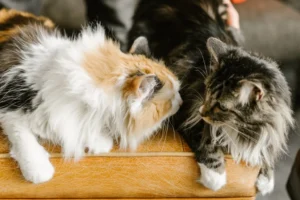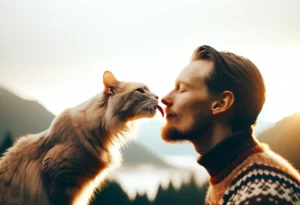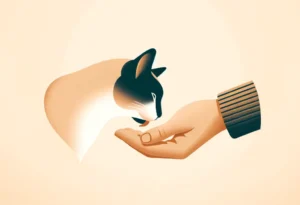Cats are known for their fastidious grooming habits, but have you ever wondered why they lick each other’s private areas? Let’s explore this interesting behavior in more detail.
Have you ever noticed your cats engaging in mutual grooming, specifically focusing on each other’s private areas? The act of cats licking each other’s private areas serves a variety of purposes, including hygiene, social bonding, and even establishing hierarchy within a group.
Understanding Mutual Grooming
Mutual grooming among cats is a fundamental aspect of their social behavior. When cats lick each other, especially in their private areas, it serves as a way for them to strengthen their social bonds. This act helps establish trust and camaraderie within a group of cats, whether they are related or not.
It’s essential to recognize that cats are meticulous groomers by nature, and grooming each other reinforces their social hierarchy and maintains a sense of peace within their group. By licking each other’s private areas, they are not only fostering social connections but also engaging in a form of non-verbal communication that conveys trust and acceptance among feline companions.
Hygiene and Scent Marking
Licking each other’s private areas may seem peculiar to us, but for cats, it’s a crucial aspect of maintaining hygiene and scent marking. Cats have scent glands located in various parts of their bodies, including their private areas, which release pheromones that carry information about their identities, territories, and emotional states.
When cats lick each other’s private areas, they are not only keeping themselves clean but also spreading their unique scent throughout their social group. This scent serves as a form of communication that helps cats recognize each other, reaffirm their group identity, and establish boundaries within their territories.
In addition to hygiene and scent marking, cats licking each other’s private areas can also be a sign of trust and intimacy. By engaging in this behavior, cats demonstrate their acceptance and affection for one another, reinforcing the bonds that hold their social group together.
Additional Insight:
- Cats have a unique grooming technique called “allogrooming,” where they specifically groom each other’s hard-to-reach areas, such as the genital region, which they may not be able to reach themselves effectively.
Remember, cats are complex creatures with intricate social dynamics, and their grooming behaviors, including licking each other’s private areas, play a vital role in maintaining harmony and communication within their social groups.
Social Bonding and Communication
Mutual grooming, including licking each other’s private areas, is like a secret handshake among cats. It’s their way of cementing friendships and showing love within their social group. By sharing these grooming sessions, cats build trust, provide comfort, and reinforce their social bonds. It’s their version of a cozy chat over a cup of tea.
Establishing Hierarchy
When cats engage in grooming behaviors, like licking each other’s private areas, they aren’t just getting squeaky clean – they’re also playing a power game. Through grooming, dominant cats show their authority and establish hierarchy within the group. By allowing others to groom them in sensitive areas, dominant cats display their status and maintain control over their peers.
Additional Insight:
- Cats often groom each other’s private areas as a sign of respect and submission. It’s a way for them to show deference to higher-ranking cats in the group hierarchy. This grooming ritual helps maintain peace and harmony within the feline social structure.
The Role of Kittens
Mutual grooming, including licking private areas, plays a crucial role in the development and socialization of kittens within a litter. When a mother cat licks her kittens’ private areas, she is not only keeping them clean but also stimulating them to help with urination and defecation. This is essential in the early stages of a kitten’s life when they are unable to do these tasks on their own. Moreover, grooming rituals like licking private areas help establish a bond between the mother cat and her offspring, creating a sense of security and comfort for the kittens.
A unique insight into this behavior is that mutual grooming, including licking private areas, also helps kittens learn about boundaries and social hierarchies within their litter. By engaging in grooming sessions, kittens can establish a pecking order based on age, dominance, and closeness to their mother. This interaction not only fosters social skills but also teaches kittens about respect, communication, and cooperation in a feline community.
Interesting Cat Facts
Did you know that cats spend up to half of their waking hours grooming themselves and other cats? This meticulous grooming behavior serves several purposes, including temperature regulation, scent marking, and social bonding. When cats lick each other’s private areas, they are not only addressing hygiene needs but also reinforcing social bonds within their group.
Another fascinating fact is that cats have specialized grooming tools on their tongues, called papillae, which are tiny, hook-like structures that help remove dirt, loose fur, and parasites from their fur. These papillae also play a role in distributing natural oils throughout a cat’s coat, keeping it healthy and glossy. So, when cats engage in mutual grooming and lick each other’s private areas, they are not only showing affection but also contributing to each other’s overall well-being.
Remember, the next time you see cats grooming each other, especially in private areas, it’s not just about cleanliness – it’s a display of deep social connections and care within the feline world.
Alex, a passionate animal lover, has experience in training and understanding animal behavior. As a proud pet parent to two dogs and three cats, he founded AnimalReport.net to share insights from animal experts and expand his knowledge of the animal kingdom.









